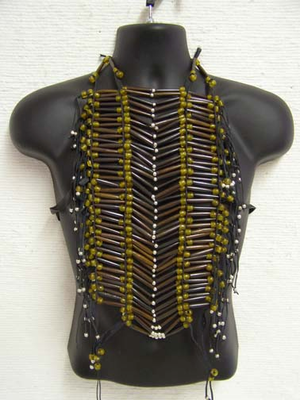Your Cart is Empty
Quick Facts
Armor for protection in battle and hunting
Used for Native dances and ceremonies
Has decorative and medicinal qualities
Handcrafted from long bone beads
Worn over a bare chest in a hot climates
Worn over a shirt in colder climates
Decorated with carved horn, shells, leathers, fringe trim, colorful beads
Can be made from Hair-pipe beads turned from water buffalo horn or from cow bone

In the hot climate of the Southwest, they were often worn over a bare chest. During winter months and in colder climates, they were often worn over a shirt. The material used in the hand crafting of breastplates dates back to pre-Columbian days for various types of Native American dress.
The two primary choices for traditional breastplates in use right now, are hair-pipe beads, turned from cow bone and left white or "tea" stained a light buff color, measuring 2" to 4" long and tapered at both ends, These are strung upon waxed stranded nylon, which is the modern substitute for deer leg sinews. The nylon resists sagging better than the traditional, and they are hung between rawhide or heavy tanned leather spacers along with glass and metal decorative "pony" sized beads.
Another hair-pipe variation are the hair-pipe beads turned from water buffalo horn, which resembles bison horn, with a deep brown or black coloring. The sinew used to string breastplates were usually from deer or Buffalo. The sinew strips from these main sources were generally not only longer than other animals; there was an abundance of them. At one time, there were more buffalo roaming around America than there were people. Before metal and needles were invented, Native Americans used a sharp piece of filed down bone as hole punchers for the hide spacers often found between the bone beads.
There are also breastplates for ceremony which are made from the long leg bones of the eagle, but these are very rare, and impossible to duplicate legally today without a Federal License for the use of eagle parts. Turkey bones bleached and clean might be a reasonable substitute. Today, Breastplates can be embellished and decorated in a number of ways. They are often decorated with carved horn, shells, leathers, fringe trim and sometimes contrasting colorful beads.